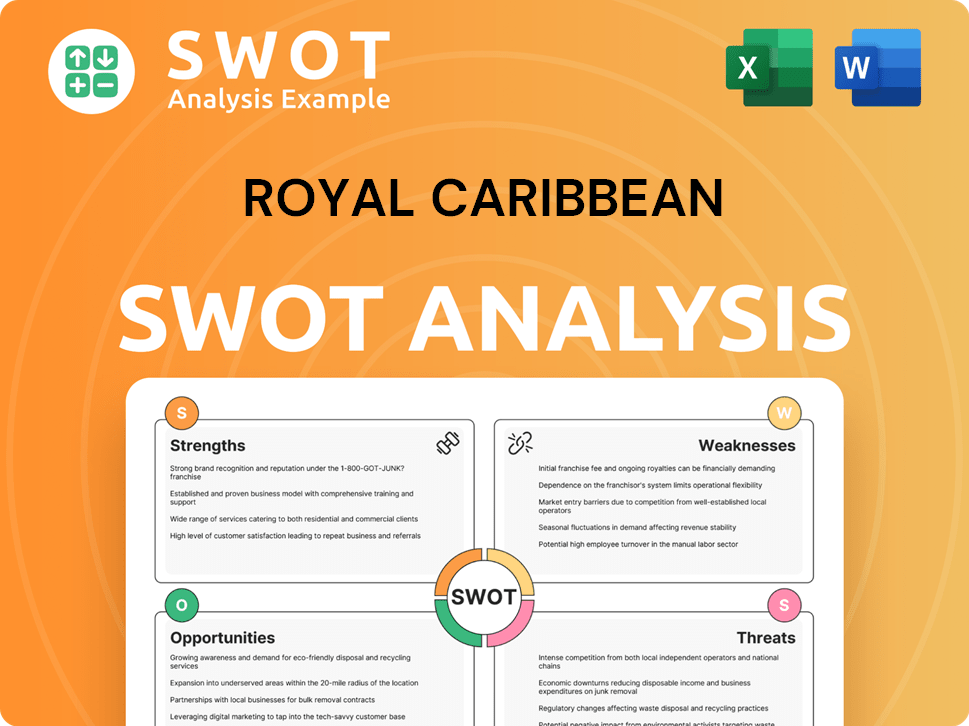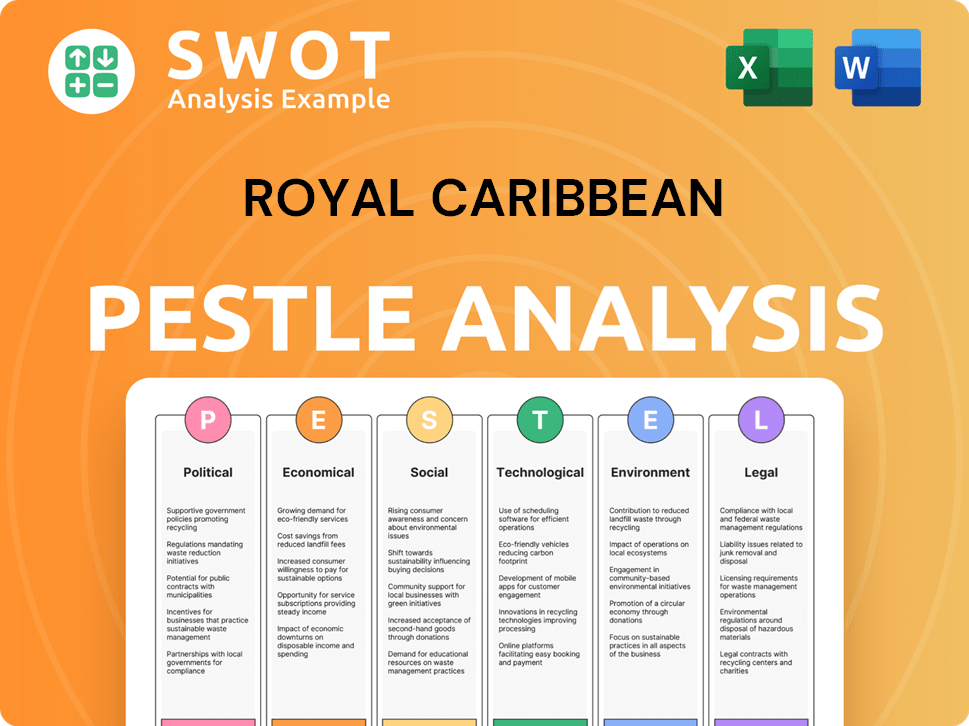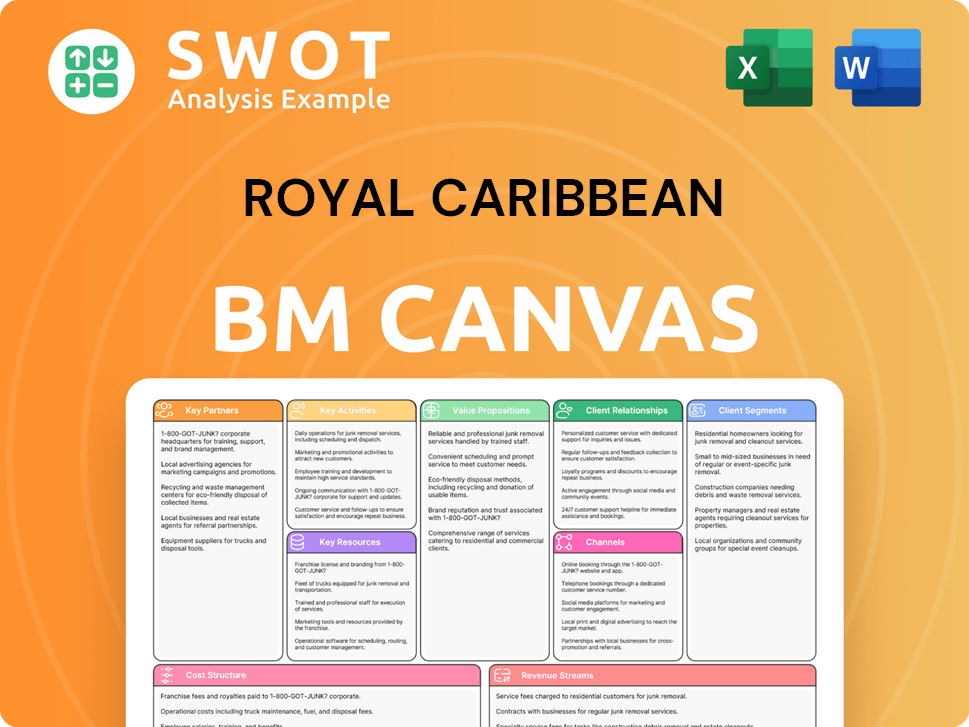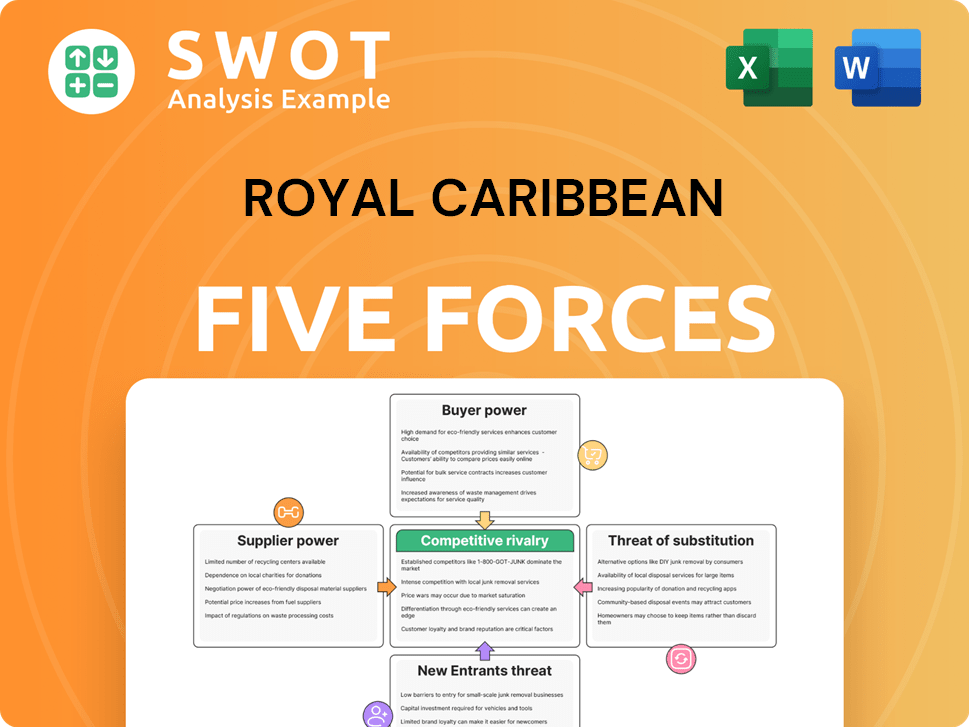Royal Caribbean Bundle
How Does Royal Caribbean Thrive in the Cruise Industry?
Royal Caribbean Group, a leading cruise company, is making waves with impressive financial results, including a $16.5 billion revenue in 2024 and an adjusted EPS of $11.80. This success story is fueled by strong demand and strategic pricing. With a diverse fleet of 65 ships and an optimistic outlook for 2025, understanding how this Royal Caribbean SWOT Analysis can help investors and industry observers alike.

The company's ability to exceed expectations, achieving its 'Trifecta goals' ahead of schedule, highlights its operational prowess. As the demand for cruise experiences continues to surge, particularly with Royal Caribbean ships, examining the operational and financial strategies of this cruise company becomes increasingly vital. This analysis will provide insights into the drivers of its growth and shed light on its ability to navigate the competitive cruise industry, offering valuable information for anyone interested in the company's financial performance and future prospects, including details on Royal Caribbean cruise prices and Royal Caribbean ship itineraries.
What Are the Key Operations Driving Royal Caribbean’s Success?
The Royal Caribbean Group, a leading cruise company, creates value through its diverse brand portfolio, each targeting specific customer segments. Royal Caribbean International focuses on large, family-oriented cruises with innovative features. Celebrity Cruises caters to premium travelers, and Silversea Cruises targets the luxury market.
The company's operational processes are centered around ship operations, marketing, and customer service, with a strong emphasis on innovation and exclusive destinations. This includes continuous investment in ship designs and technologies to enhance the onboard experience and attract diverse travelers. Royal Caribbean also highlights its commitment to sustainability, investing in energy-efficient ships and responsible tourism practices.
Royal Caribbean's operational strategy translates into customer benefits such as diverse activities, exceptional service, and memorable vacation experiences, leading to strong brand loyalty and market differentiation. The company's focus on exclusive destinations, such as Perfect Day at CocoCay, provides unique offerings that differentiate it from competitors and contribute to higher ticket prices and increased on-shore spending. Understanding the Marketing Strategy of Royal Caribbean provides further insights.
Royal Caribbean Group operates several cruise lines, including Royal Caribbean International, Celebrity Cruises, and Silversea Cruises. Each line targets different market segments, offering a range of experiences from family-friendly vacations to luxury travel. This multi-brand approach allows the company to cater to a wide variety of customer preferences and price points.
The core of Royal Caribbean's operations involves managing a global fleet of ships, including Royal Caribbean ships. This includes ship maintenance, crew management, and ensuring passenger safety and comfort. The company invests in innovative ship designs and technologies to enhance the onboard experience. The company's fleet consists of 63 ships as of 2024.
Royal Caribbean utilizes extensive marketing and sales strategies to attract customers. This includes partnerships with travel advisors, online advertising, and direct sales efforts. The company focuses on promoting its unique destinations and onboard experiences to drive bookings. In 2024, the company's marketing expenses were approximately $1.3 billion.
Providing excellent customer service is a key focus for Royal Caribbean. This includes pre-cruise support, onboard assistance, and post-cruise follow-up. The company aims to create memorable vacation experiences that foster brand loyalty. The company's customer satisfaction scores have consistently been above 85%.
Royal Caribbean's value proposition centers on offering diverse vacation experiences, exceptional service, and unique destinations. The company differentiates itself through innovative features and exclusive offerings. This strategy aims to provide memorable vacations and build strong customer loyalty.
- Diverse Activities: Offering a wide range of onboard activities, including rock climbing, ice skating, and surfing simulators.
- Exclusive Destinations: Developing private destinations like Perfect Day at CocoCay and Royal Beach Clubs.
- Exceptional Service: Providing high-quality customer service and personalized experiences.
- Brand Loyalty: Building strong customer loyalty through memorable vacations and exceptional service.
Royal Caribbean SWOT Analysis
- Complete SWOT Breakdown
- Fully Customizable
- Editable in Excel & Word
- Professional Formatting
- Investor-Ready Format

How Does Royal Caribbean Make Money?
The primary revenue streams and monetization strategies of the Royal Caribbean Group revolve around ticket sales and onboard activities and services. In 2024, the company reported total revenues of approximately $16.5 billion. This figure underscores the significant financial scale of the cruise company.
The company's financial performance is significantly influenced by passenger ticket revenue, alongside revenue generated from onboard activities and other services. For the first quarter of 2025, the total revenues reached $4.0 billion, highlighting the ongoing financial dynamics.
Royal Caribbean continues to see strength in onboard revenue, driven by increased participation and higher prices for services. This strategy contributes significantly to the company's overall profitability and financial health. For more information about the company, visit Owners & Shareholders of Royal Caribbean.
The cruise line employs several innovative monetization strategies to enhance revenue. These include value-added packages that bundle services, premiumization, and loyalty programs. These strategies are designed to increase revenue per passenger and improve customer loyalty.
- Value-Added Packages: These packages combine dining, beverages, shore excursions, and onboard activities into all-inclusive offerings.
- Premiumization: This involves higher cabin pricing and increased onboard spending, driving yield growth.
- Loyalty Programs: These programs deepen customer engagement and encourage repeat bookings, with members accounting for around 50% of room nights booked.
- Private Destinations: The development of exclusive private destinations contributes to higher ticket prices and increased spending on shore.
- Capacity Expansion: The company anticipates a 5.5% capacity increase in 2025, fueled by new ships and expanded deployment, which is expected to boost revenue further.
Royal Caribbean PESTLE Analysis
- Covers All 6 PESTLE Categories
- No Research Needed – Save Hours of Work
- Built by Experts, Trusted by Consultants
- Instant Download, Ready to Use
- 100% Editable, Fully Customizable

Which Strategic Decisions Have Shaped Royal Caribbean’s Business Model?
The Royal Caribbean Group has demonstrated significant strategic prowess, marked by key milestones and forward-thinking moves. In 2024, the company achieved its 'Trifecta goals' ahead of schedule, signifying strong execution and progress on strategic priorities. The reinstatement of dividends to shareholders in 2024 further underscores its financial health and commitment to stakeholders.
New product launches and market entries are central to the company's growth strategy. The delivery of new ships, such as Utopia of the Seas and Silver Ray in 2024, along with the upcoming launches of Star of the Seas and Celebrity Xcel in 2025, are set to expand capacity and enhance offerings. Strategic partnerships and business model pivots, including the announcement of Celebrity River Cruises, aim to capture a larger share of the global vacation market. Expansion of private destinations, such as Royal Beach Club Cozumel and Perfect Day Mexico, further diversifies its portfolio.
The company navigates operational challenges, including macroeconomic pressures like fuel costs and inflation, which can impact operating margins. Geopolitical risks and fluctuations in consumer confidence also influence booking trends. Royal Caribbean mitigates these challenges through hedging strategies for fuel consumption and targeted cost control measures.
In 2024, the company reached its 'Trifecta goals' ahead of schedule. The reinstatement of dividends in 2024 highlights financial stability. New ship deliveries, such as Utopia of the Seas, contribute to capacity expansion.
The launch of Celebrity River Cruises expands market reach. Expansion of private destinations, like Royal Beach Club Cozumel, diversifies offerings. The upcoming launches of Star of the Seas and Celebrity Xcel in 2025 will further enhance offerings.
Strong brand recognition and innovative ship designs differentiate the company. Economies of scale from operating large ships allow for competitive pricing. The company focuses on sustainability initiatives and digital transformation.
Rising fuel costs and inflation can impact operating margins. Geopolitical risks and consumer confidence fluctuations influence booking trends. Hedging strategies and cost control measures help mitigate these challenges.
Royal Caribbean's competitive advantages include strong brand recognition, innovative ship designs, and exclusive onboard amenities. The company's commitment to innovation, from smart ship designs to enhanced onboard experiences, differentiates it from competitors. Economies of scale, achieved by operating large ships, allow the company to spread fixed costs and offer competitive pricing. The company continues to adapt to new trends, such as sustainability initiatives and digital transformation, and is focusing on expanding into new markets and enhancing onboard technology. For more insights, you can explore the Competitors Landscape of Royal Caribbean.
- Strong brand recognition and innovative ship designs.
- Economies of scale through large ship operations.
- Adaptation to sustainability and digital transformation.
- Focus on expanding into new markets and enhancing onboard technology.
Royal Caribbean Business Model Canvas
- Complete 9-Block Business Model Canvas
- Effortlessly Communicate Your Business Strategy
- Investor-Ready BMC Format
- 100% Editable and Customizable
- Clear and Structured Layout

How Is Royal Caribbean Positioning Itself for Continued Success?
The cruise industry is dominated by major players, with Royal Caribbean Group holding a significant position. As of May 2025, the company's market capitalization reached $64.03 billion, reflecting its strong standing in the sector. Despite competition from larger fleets, Royal Caribbean's brand strength and innovative offerings contribute to its success. The company's load factor of 109% in Q1 2025 highlights high demand and efficient capacity utilization.
However, Royal Caribbean faces various risks. Economic downturns, rising fuel costs, and inflation can impact profitability. Geopolitical events and changing consumer preferences add to the challenges. Furthermore, environmental concerns and regulations necessitate investments in cleaner technologies. Potential tax hikes also pose a risk to the company's financial performance. For more information, you can explore the Brief History of Royal Caribbean.
Royal Caribbean is the second-largest cruise line operator globally, with a strong brand and diverse fleet. High demand is evident, as shown by a 109% load factor in Q1 2025. The company's market capitalization reflects its significant value in the cruise sector, making it a leader in the industry.
Economic downturns, fuel costs, and inflation pose risks to profitability. Geopolitical risks and changing consumer preferences also present challenges. Environmental regulations and potential tax hikes add to the uncertainties. These factors can impact the company's financial performance.
The company anticipates strong growth, with bookings for 2025 already robust and at higher prices. Royal Caribbean expects an adjusted EPS growth of approximately 28% year-over-year in 2025, ranging from $14.55 to $15.55. Capacity is projected to grow 5.5% in 2025.
The 'Perfecta Program' targets a 20% compound annual growth rate in Adjusted EPS and a Return on Invested Capital in the high teens by 2027. Royal Caribbean is committed to reducing carbon intensity by 15% or greater compared to 2024. These initiatives aim to sustain and expand profitability.
Royal Caribbean's strong industry position is supported by its brand and innovation. The company faces risks from economic factors and regulations. The future outlook is positive, driven by strong bookings and strategic initiatives.
- Strong demand and high load factors indicate a healthy market.
- The company is investing in new ships and environmental sustainability.
- Strategic programs aim for significant financial growth by 2027.
- Capacity growth of 5.5% is planned for 2025.
Royal Caribbean Porter's Five Forces Analysis
- Covers All 5 Competitive Forces in Detail
- Structured for Consultants, Students, and Founders
- 100% Editable in Microsoft Word & Excel
- Instant Digital Download – Use Immediately
- Compatible with Mac & PC – Fully Unlocked

Related Blogs
- What are Mission Vision & Core Values of Royal Caribbean Company?
- What is Competitive Landscape of Royal Caribbean Company?
- What is Growth Strategy and Future Prospects of Royal Caribbean Company?
- What is Sales and Marketing Strategy of Royal Caribbean Company?
- What is Brief History of Royal Caribbean Company?
- Who Owns Royal Caribbean Company?
- What is Customer Demographics and Target Market of Royal Caribbean Company?
Disclaimer
All information, articles, and product details provided on this website are for general informational and educational purposes only. We do not claim any ownership over, nor do we intend to infringe upon, any trademarks, copyrights, logos, brand names, or other intellectual property mentioned or depicted on this site. Such intellectual property remains the property of its respective owners, and any references here are made solely for identification or informational purposes, without implying any affiliation, endorsement, or partnership.
We make no representations or warranties, express or implied, regarding the accuracy, completeness, or suitability of any content or products presented. Nothing on this website should be construed as legal, tax, investment, financial, medical, or other professional advice. In addition, no part of this site—including articles or product references—constitutes a solicitation, recommendation, endorsement, advertisement, or offer to buy or sell any securities, franchises, or other financial instruments, particularly in jurisdictions where such activity would be unlawful.
All content is of a general nature and may not address the specific circumstances of any individual or entity. It is not a substitute for professional advice or services. Any actions you take based on the information provided here are strictly at your own risk. You accept full responsibility for any decisions or outcomes arising from your use of this website and agree to release us from any liability in connection with your use of, or reliance upon, the content or products found herein.